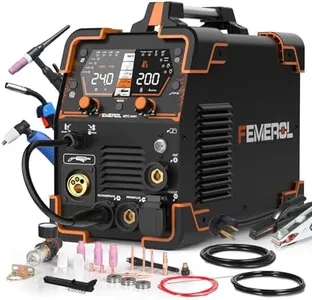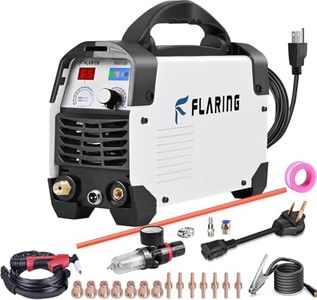We Use CookiesWe use cookies to enhance the security, performance,
functionality and for analytical and promotional activities. By continuing to browse this site you
are agreeing to our privacy policy
3 Best Plasma Cutters
From leading brands and best sellers available on the web.Buying Guide for the Best Plasma Cutters
When choosing a plasma cutter, it's important to focus on how you'll actually use it. Start by thinking about the types of materials you plan to cut, their thickness, and how often you'll be using the machine. Understanding the basics will help you match your needs to the most appropriate features and keep you from paying for capabilities you don’t need or missing out on essential functions.Cutting ThicknessCutting thickness refers to the maximum thickness of metal the plasma cutter can efficiently and cleanly cut. It's important to match this to the thickest material you plan on cutting most often. Plasma cutters are usually rated for a 'clean cut' and sometimes for a 'severance cut,' which is thicker but less precise. Thin-gauge applications can work with lighter-duty models rated for 1/4 inch or less; general-purpose needs might look for models around 1/2 inch, while heavy-duty or industrial work needs ratings of 1 inch or more. Choose a cutter that regularly covers your typical needs with a bit of headroom for occasional thicker materials.
Input PowerInput power determines what kinds of electrical outlets your plasma cutter can use. This is usually 110V (120V), 220V (240V), or dual voltage. Lower voltage (110V/120V) models are fine for lighter tasks and can plug into standard outlets at home, but they limit the machine’s cutting capacity. Higher voltage (220V/240V) models let you cut thicker materials but might require a special outlet. If you value convenience and flexibility, dual-voltage models automatically adapt and are great for varied environments. Check what power is available where you’ll use the cutter before deciding.
Duty CycleDuty cycle tells you how long the plasma cutter can operate within a ten-minute period before it needs to cool down. It's shown as a percentage at a certain amperage (for example, 60% at 40 amps means 6 minutes of use and 4 minutes of rest). A higher duty cycle means the machine can run longer without stopping, which is crucial for big projects or frequent cutting. For light or occasional use, a lower duty cycle may be fine, but for professional or intense tasks, a high duty cycle is a must.
PortabilityPortability describes how easy it is to move and handle the plasma cutter. Lighter units, often weighing less than 30 pounds, are ideal if you plan to move the machine around a lot—for example, to different job sites or locations in your shop. Heavier units tend to have more power or features but may be bulkier and harder to transport. Consider how mobile you'll need to be and if you’ll want features like carrying handles or built-in wheels.
Compressor TypePlasma cutters need a source of compressed air. Some models have a built-in air compressor, which makes the unit more self-contained and portable, but might also increase the weight and initial cost. Others rely on an external compressor, which can offer better performance and airflow but requires extra equipment. If you already own a suitable air compressor or need a more powerful airflow for long or thick cuts, an external type could be better. For quick jobs or maximum convenience, a built-in compressor model might suit you.
Pilot Arc CapabilityPilot arc technology allows the plasma cutter to start the arc without direct contact with the metal. This makes it easier to cut through rusted, painted, or expanded metal, and it helps extend the life of your cutting tip. Not all models include pilot arc, but if you’ll be dealing with less-than-pristine materials or want smoother starts and finishes, look for this feature. For those always working with clean plate, it’s less essential.




